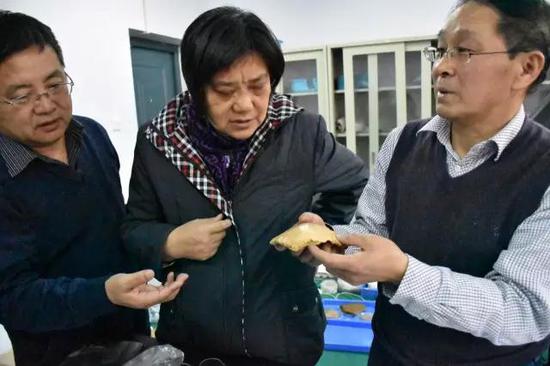The secrets of Xuchang Man
china.org.cn / chinagate.cn by Gong Jie, March 31, 2017 Adjust font size:
 |
|
Li Zhanyang (1st R) discusses the human cranial fossil with other experts on March 7. [Photo/Beijing News] |
Fossil dated
The fossils were then sent to the best laboratory in Peking University to calculate the date.
Laboratory head Zhou Liping said that they tested the sediment around the fossils to calculate the date. The result of the test proved that these fragments had been buried 105,000 -- 125,000 years ago.
"This is a new evidence to support the 'multiregional view' of human origin," said Wu Xinzhi, a paleoanthropologist and academician of the Chinese Academy of Sciences.
Are Xuchang humans ancestors of East Asians?
Until May 2014, 45 human cranial fossils had been found by Li and his team around the site.
Wu Xiujie, a researcher with the Institute of Vertebrate Paleontology and Paleoanthropology of the Chinese Academy of Sciences, restored the fossils into two relatively complete crania with modern technology.
After using CT scanning and 3D technology to make comparisons with other human fossils found in other parts of the world, Wu said Xuchang Man bears characteristics of East Asia hominids, modern humans and Neanderthals.
One cranium has a huge brain volume of 1,800 cubic centimeters, which is larger than the 1,400 cubic centimeters of a modern human. The brain volume of the other cranium is almost the same as that of modern humans. Like the latter, the skulls have modest brow lines, lightly built cranial vaults and large brain capacity.
However, they also have the same semicircular ear canals, and enlarged section at the back of the skull, as Neanderthals.
And there are traits of East Asian hominids, too, such as a low and broad braincase that rounds onto the inferior skull.
Wu said that Xuchang Man is a new species with similarities of modern humans, East Asian hominids and Neanderthals.
Li believes that the Chinese hominids migrated to warmer European regions during an ice age and crossbred with the early Neanderthals there. During the last interglacial stage, when the climate got warmer, the ancestors of Xuchang Man came back to north China. The migration might have happened many times due to climate change.